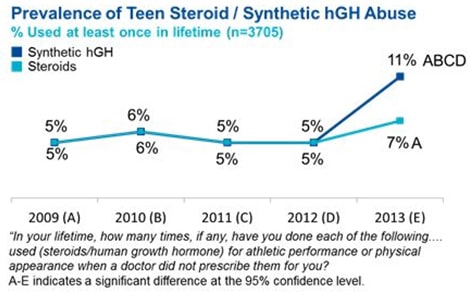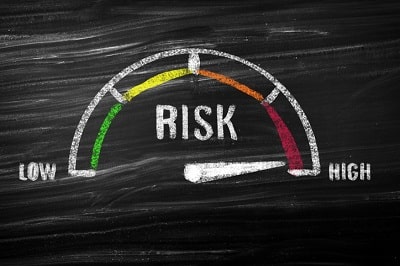HGH use — both legal and illegal – is on the rise in the US. When growth hormone medication is administered properly under the guidance of an endocrinologist (hormone expert), it is an exceptionally safe treatment modality that produces reliably positive results for individuals with growth hormone deficiency (GHD).
On the other hand, when HGH is abused, or the medications sold on the black or gray markets are fake or contaminated, serious health consequences – often causing permanent disability or even death — can result. Here, we will delve into the dangers of illicit HGH use, its risks, and how to protect yourself from potential harm caused by HGH abuse and/or fake HGH supplements.
Performance-Enhancing Drugs (PEDs): HGH Abuse Among Bodybuilders, Weightlifters, and Other Athletes
The category of “performance-enhancing drugs” (“PEDs”) refers to any substance that athletes use to gain a competitive advantage by boosting their performance on the field or in the weight room. PED use has a storied history that dates back centuries:
“Gladiators of Roman times used to ingest strychnine to avoid injury and to decrease fatigue. During the 1950s, the Soviet Union dominated power lifting by providing their wrestlers with testosterone injections. In the 1960s, Sports Illustrated documented the use of amphetamines, tranquilizers, cocaine, and other drugs by professional athletes.”
The definition of what substances exactly fall into the “PEDs” umbrella is controversial. As Dr. Alex Mauron, an expert on the legal and ethical issues of doping in sports, says:
“The argument against doping cannot define precisely the border between what is doping and what is not doping…The problem I think is that anti-doping policies have a hard time defining precisely the limit between what is acceptable and what is not.”

Nonetheless, most sporting organizations have a strict zero-tolerance policy for a number of substances in the athletes that they monitor, including HGH. The top sporting organizations that ban HGH use in athletes who compete in their respective events include:
- World Anti-Doping Agency (WADA).
- US Anti-Doping Agency (USADA).
- Association of Summer Olympic International Federations (ASOIF).
- International Weightlifting Federation (IWF).
Testing positive for HGH can disqualify an athlete from competition, harm the athlete’s reputation, and potentially have lasting effects on his or her career. Competing in the upper echelons of any sport requires peak physical conditioning. Even the smallest advantage in reflex, strength, or speed can confer an advantage that means the difference between winning or losing or between first and second place.
Many athletes believe that HGH is the boost that they need to get to the top of the pyramid. The WADA regularly publishes and updates its list of banned substances. Per WADA regulations, HGH (a peptide hormone) is not allowed at any stage of training or competition.
PED Use in 2021: What Is on the Black Market?
The most common and popular PEDs among athletes include:
- Steroids (Testosterone).
- Human chorionic gonadotropin (HCG).
- Amphetamines.
- Erythropoietin (EPO).
- Human growth hormone (HGH).
According to reporting from the WADA, thousands of athletes in the US and worldwide fail standard drug tests in competitive sports.
The Disturbing Rise of Adolescent Human Growth Hormone Abuse
 Unfortunately, PED use – and HGH abuse in particular — has filtered into lower age groups for athletes due to the perceived benefits in athletic performance that they supply. The data, illustrated in the chart above, indicates that HGH use skyrocketed among teens around 2013 as the drug became more readily available on the black market.
Unfortunately, PED use – and HGH abuse in particular — has filtered into lower age groups for athletes due to the perceived benefits in athletic performance that they supply. The data, illustrated in the chart above, indicates that HGH use skyrocketed among teens around 2013 as the drug became more readily available on the black market.
According to Dr. Patricia Vuguin, a children’s hormone specialist, public health initiatives are needed to curb this disturbing trend:
“The marked increase in teens’ reported use of performance-enhancing substances such as steroids or synthetic growth hormones over just the last few years cries out for a massive public health campaign to educate them about the catastrophic — and even fatal — potential risks of misusing such products.”
Is It Safe to Use hGH Without a Prescription?
Using HGH without a prescription is not safe under any circumstances. Many individuals without a medical need for HGH – including athletes looking for a performance boost – use HGH without a prescription. In addition to being dangerous for health, supplementing with HGH without the supervision of a doctor is illegal in the United States. Violators can potentially face a decade or more behind bars and heavy fines.
How to Avoid Counterfeit
The World Health Organization (WHO) reports that roughly 10% of all medical supplies from developing regions of the world are “false” or “substandard.” Drugs labeled as “false” or “substandard” are counterfeit, contaminated with unknown/foreign substances, or ineffective.
Fake and substandard drugs are typically significantly cheaper than official, licensed, legal ones.
Because all of the HGH traded in gyms, clubhouses, and schools around the country is sold on the black market, many of the products marketed as HGH are actually false or substandard drugs imported from regions such as Africa or Asia.
The Health Risks of Various HGH Medications
Different HGH medications come with their own safety profiles and unique sets of risks.
HGH Pills
HGH pills usually contain a combination of amino acids (the building blocks of growth hormone) such as:
- Glutamine.
- Arginine.
- Lysine.
- Glycine.
- Tyrosine.
- Aspartic acid.
The Food and Drug Administration (FDA) does not regulate oral HGH supplements in the same way that it regulates somatropin, the synthetic pharmaceutical version of natural HGH. Accordingly, many HGH pill manufacturers also add untested and unproven ingredients to their supplements, which can be dangerous. Ingredients often added to HGH pills can include:
- Soy Phosphate Complex.
- Ginseng.
- Gingko Biloba.
- Maca Root.
- Hawthorne Berry Extract.
- Mucuna Pruriens.
None of these ingredients commonly contained in unregulated HGH supplements is approved by the FDA or any other medical group to boost growth hormone levels in humans.
Furthermore, how an individual will react to this potentially dangerous mix of ingredients – especially when taken in combination with one another – is nearly impossible to predict due to his or her unique physiology and the untested nature of HGH pills.  Mick Hart, an expert on PED use, explains the health hazards of unregulated HGH pills and similar HGH supplements in laymen’s terms:
Mick Hart, an expert on PED use, explains the health hazards of unregulated HGH pills and similar HGH supplements in laymen’s terms:
“They are finding trace elements of metals in phials being shipped in from all over the place, as any wannabe dealer with a metal drum in places like China and Russia is attempting to make them on the cheap. That can be lethal.”
Pituitary-Derived Human Growth Hormone (pit-HGH)
The earliest form of HGH used in medicine was taken from human cadavers to be transplanted directly into the recipient’s blood. This type of HGH is known as “pituitary-derived human growth hormone,” or “pit-HGH.” Clinical use of pit-HGH is extremely dangerous, often resulting in extreme neurodegenerative disease, including Creutzfeldt-Jakob disease (CJD).
In an emergency move, the Health and Human Services federal department immediately halted distribution of pit-HGH in 1985. Today, modern technology allowing for the creation of synthetic HGH in labs has largely eliminated pit-HGH from the drug supply. The good news for HGH therapy patients is that, in 2021, pit-HGH is extremely rare on American streets due to the extreme side effects. No licensed, responsible doctor will prescribe pit-HGH.
Sogroya (Somapacitan)
Somapacitan — marketed as Sogroya in the US – is the newest HGH medication on the market. The FDA approved its use in August 2020. The major advertised advantage that somapacitan offers compared to other HGH medications is that users only require injections once per week, as opposed to every day. Somapacitan use, though, does carry a significant risk of side effects, including:
- Back pain.
- Joint pain.
- Indigestion.
- Dizziness.
- Tonsillitis.
- Adrenal insufficiency.
- Hypertension.

Somatropin (rHGH)
Somatropin — often referred to as “recombinant human growth hormone” or “rHGH” – is the most thoroughly tested HGH medications in use today. Because somatropin matches the structure of naturally-occurring HGH produced in the pituitary gland, it is notably safer than other HGH medications.
Millions of patients around the world with growth hormone deficiency (GHD) achieve elevated HGH levels with minimal risk of side effects. Nonetheless, somatropin abuse and/or supplementation without proper medical supervision may trigger both short and long-term side effects that can include:
- Nausea.
- Vomiting.
- Headache.
- Weakness and/or fatigue.
- Muscle pain.
- Swelling (edema) in the extremities (rare).
- Enlargement of the hands, feet, or head (acromegaly) (rare).
- Carpal tunnel syndrome (rare).
- Insulin resistance (rare).
How To Minimize the Risks of Growth Hormone Treatment
Below is a handful of time-tested strategies to minimize the risk of HGH side effects during HRT:
- Always consult with a licensed, experienced endocrinologist before, during, and after the completion of therapy. These experts are trained to notice side effects and, when necessary, to adjust the therapy protocol or medication to avoid long-term negative health effects.
- Keep a daily personal journal throughout HGH supplementation in which you record any side effects and general feelings surrounding therapy. Bring the journal to your doctor’s appointments to discuss any concerns.
- Only use HGH medications that are approved by the FDA. The Food and Drug Administration (FDA) regulates the sale and use of HGH in the United States. FDA-approved medications are verified for safety and quality.

